Enhanced Glossary
OMPRN is committed to improving the understanding of molecular pathology for everyone in the province. To help with this, we have created an “enhanced glossary” for common cancer, genetics and molecular pathology terms. Our enhanced glossary goes beyond traditional term definitions to include term definitions, audio pronunciation, illustrative images, contextual examples and more.
Please note that any information you find here is for educational purposes only

Allele
fr: allèle
One of two or more versions of a gene or DNA sequence at a particular region on a chromosome. A person has two alleles for each gene, one inherited from each parent.
Example: The patient’s genetic profile exhibited a variation in the BRCA1 gene, with one allele carrying a pathogenic mutation associated with an increased risk of hereditary breast cancer.
Relevant Lessons:
Citations:

Amino Acid
fr: acide aminé
An amino acid is the basic molecule that serves as the building blocks for proteins. There are 20 different amino acids. Some amino acids can be synthesized in the body; however, others (essential amino acids) must be obtained from a person’s diet.
Example: A DNA mutation caused an amino acid change that disrupted the normal function of the protein.
Relevant Lessons:
Citations:

Angiogenesis
fr: Angiogenèse
Angiogenesis is the process of new capillaries forming out of preexisting blood vessels in your body. It’s normally a helpful, important process that supports wound healing and supplies oxygen-rich blood to your organs and tissues. But in people with cancer, angiogenesis supports tumor growth and spread by feeding tumors with oxygen and nutrients.
Example: Extensive angiogenesis was detected at the tumour site. This prompted the doctor to recommended a treatment to block this and slow the tumor’s growth.
Relevant Lessons:
Citations:

Autosomal
fr: autosomique
Is associated with any of the 22 numbered pairs of chromosomes found in most human cells. Autosomal chromosomes are numbered 1-22. The sex chromosomes (X and Y chromosomes) determine whether an individual is male or female and are not considered autosomal chromosomes.
Example: The BRCA1 gene is located on chromosome #17. Variants in BRCA1 are transmitted in an autosomal dominant pattern within a family.
Relevant Lessons:
Citations:
https://www.cancer.gov/publications/dictionaries/genetics-dictionary/def/autosomal
https://study.com/academy/lesson/autosomes-definition-lesson-quiz.html

Benign
fr: bénigne (feminine), bénin (masculine)
Not cancer. Benign tumors may grow larger but do not spread to other parts of the body.
Also called nonmalignant.
Example: Based on its appearance and the absence of abnormal cancer biomarkers, the pathologist determined that the tumor was benign.
Relevant Lessons:
Citations:
https://www.cancer.gov/publications/dictionaries/cancer-terms/def/benign
https://www.verywellhealth.com/what-does-malignant-and-benign-mean-514240

Bioinformatics
fr: Bioinformatique
Bioinformatics is a field of study that analyzes biological data by combining biology, computer science, mathematics and statistics.
Example: In the clinical trial study, the researchers used bioinformatics to predict the efficiency and effectiveness of precision medicine based on a patient’s genotype.
Relevant Lessons:
Citations:

Biomarkers
fr: Biomarqueurs
A biological molecule found in blood, other body fluids, or tissues that is a sign of a normal or abnormal process, or of a condition or disease. A biomarker may be used to see how well the body responds to a treatment for a disease or condition. Also called molecular marker and signature molecule.
Example: In molecular pathology, researchers are actively exploring the identification and validation of specific biomarkers that can serve as indicators of disease presence, progression, or response to treatment, providing valuable insights into personalized medicine.
Relevant Lessons:
Citations:
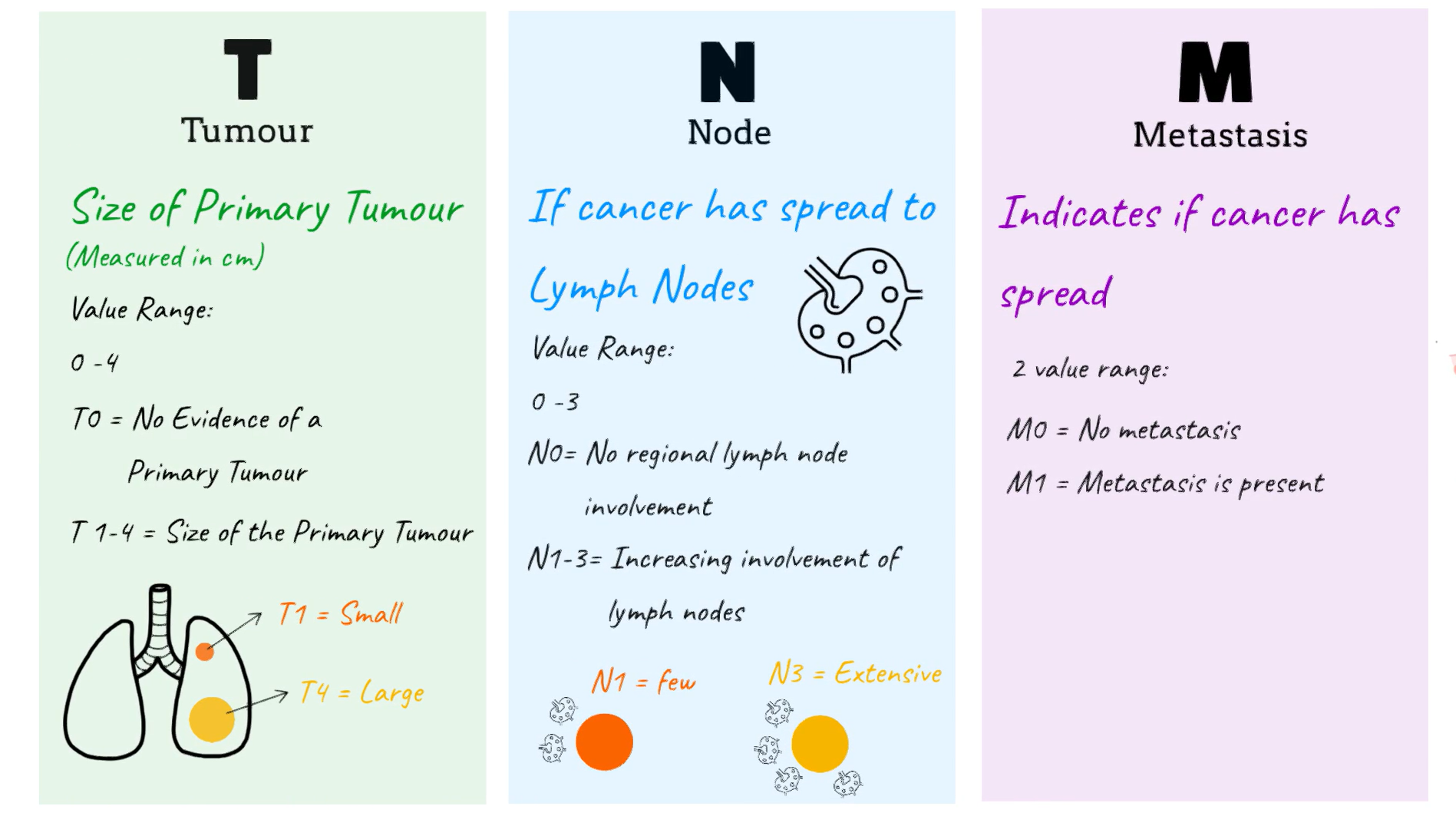
Cancer Stage
fr: Stadification du cancer
Stage refers to the extent of your cancer, such as how large the tumor is and if it has spread.
Example: The doctor explained that knowing the cancer stage would help them choose the most effective treatment plan.
Relevant Lessons:
Citations:

Carcinoma
fr: carcinome
Cancer that begins in a part of the skin or in the layer of cells that covers internal organs.
Example: The biopsy confirmed the diagnosis of invasive ductal carcinoma of the breast.
Relevant Lessons:
Citations:
https://www.cancer.gov/publications/dictionaries/cancer-terms/def/carcinoma
https://www.cancer.gov/publications/dictionaries/cancer-terms/def/carcinoma-in-situ

Carrier
fr: porteur
An individual who has one copy of a variant allele that is associated with a recessive genetic disorder. Carriers do not exhibit symptoms of the disorder.
Example: Genetic counseling identified the patient as a carrier of a hereditary cancer susceptibility gene.
Relevant Lessons:
Citations:
https://www.cancer.gov/publications/dictionaries/genetics-dictionary/def/carrier
https://en.dexeus.com/genetics/genetic-carrier-screening-qcarrier

Cellular Biomarker
fr: Biomarqueurs cellulaires
Indicators related to cell structure, function, or activity. Cellular Biomarkers are used to see if there are any abnormal cellular activities or structures indicative of cancer.
Example: The cellular biomarker Ki-67 was detected by the pathologist. This indicated that the cancer cells were growing quickly, which caused the oncologists to be more aggressive with their treatment approach.
Relevant Lessons:

Chromosome
fr: chromosome
A structure found inside the nucleus of a cell. A chromosome is made up of proteins and DNA organized into genes. Each cell normally contains 23 pairs of chromosomes.
Example: The oncologist explained that the cancer cells exhibited an abnormal number of chromosomes, which could influence the tumor’s behavior and response to treatment.
Relevant Lessons:
Citations:
https://www.genome.gov/genetics-glossary/Chromosome
https://www.cancer.gov/publications/dictionaries/genetics-dictionary/def/chromosome

Circulating Tumor Cells (ctc)
fr: cellules tumorales circulantes (ctc)
Circulating tumor cells (CTCs) are tumor cells that become dislodged from the primary tumor. These cells enter the bloodstream and if they land in favourable sites, they could form metastases.
Example: By analyzing circulating tumor cells isolated from the patient’s blood sample, we can gain insights into the molecular characteristics of the cancer without the need for a more invasive tissue biopsy.
Relevant Lessons:
Citations:
https://www.thelancet.com/journals/ebiom/article/PIIS2352-3964(22)00419-4/fulltext#:~:text=Circulating%20tumor%20cells%20(CTCs)%20are,and%20prognosis%20through%20liquid%20biopsy.
https://www.researchgate.net/figure/Proposed-mechanisms-for-CTC-ctDNA-and-miRNA-release-into-the-CSF-1-miRNAs-and-ctDNA_fig1_32560593

Clinical Trials
fr: essai clinique
A clinical trial is a research study involving human participants that evaluates the safety and/or effects of one or more interventions on health outcomes. Interventions include, but are not limited to, drugs, vaccines, radiopharmaceuticals, cells and other biological products, surgical procedures, radiologic procedures, devices, genetic therapies, natural health products, process-of-care changes, preventive care, manual therapies, and psychotherapies.
Example: Next-generation sequencing detected an ALK gene rearrangement. While the patient is eligible for ALK inhibitors, participation in a clinical trial targeting ALK fusions is also recommended.
Relevant Lessons:
Citations:
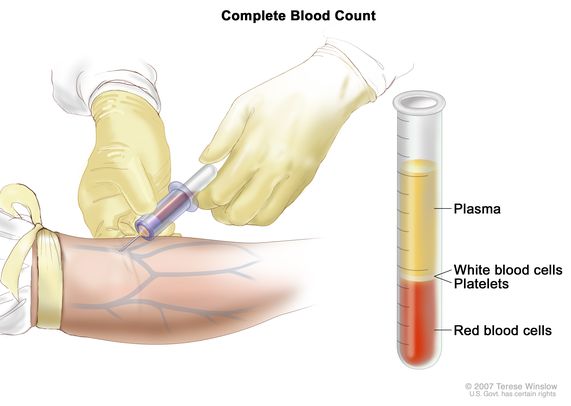
Complete Blood Count (CBC)
fr: Formule sanguine complète (FSC)
A complete blood count (CBC) is a blood test. It’s used to look at overall health and find a wide range of conditions, including anemia, infection and leukemia.
Example: A complete blood count (CBC) revealed low platelet levels, which led to an adjustment in treatment strategies.
Relevant Lessons:
Citations:

Control Group
fr: contrôle
In a clinical trial, the control group refers to patients who do not receive the new treatment being studied. Patients in group are compared to patients who receive the new treatment, to see if the new treatment works.
Example: The clinical trial incorporated a control group that received a standard treatment , enabling researchers to compare the effects of the experimental drug.
Relevant Lessons:
Citations:
https://www.cancer.gov/publications/dictionaries/cancer-terms/def/control-group
https://www.scribbr.com/methodology/control-group/

Copy Number Variation (CNV)
fr: Variation du nombre de copies
CNV refers to a type of genetic variation where the number of copies of a particular segment of DNA varies from one individual to another. These variations can range from small deletions or duplications to larger structural changes in the genome.
Example: Researchers are investigating how copy number variation contributes to the growth and spread of cancer cells, aiming to develop targeted therapies in future.
Relevant Lessons:
Citations:
https://www.ncbi.nlm.nih.gov/pmc/articles/PMC10653745/#:~:text=Copy%20number%20variants%20(CNVs)%20are,around%20genomic%20profiles%20of%20cancers.
https://upload.wikimedia.org/wikipedia/commons/7/72/Gene-duplication.png

Circulating Tumor DNA (ctDNA)
fr: ADN tumoral circulant (ADNc)
Circulating tumor DNA (ctDNA) is found in the bloodstream and refers to DNA that comes from cancerous cells and tumors. Most DNA is inside a cell’s nucleus. As a tumor grows, cells die and are replaced by new ones. The dead cells get broken down and their contents, including DNA, are released into the bloodstream. ctDNA are small pieces of DNA, usually comprising fewer than 200 building blocks (nucleotides) in length.
Example: Circulating tumor DNA (ctDNA) refers to small pieces of DNA from cancer cells that end up in the bloodstream. DNA is normally inside a cell’s nucleus but as tumour cells die, their DNA gets broken down and released into the bloodstream.
Relevant Lessons:
Citations:

Diagnostic Biomarker
fr: Biomarqueurs diagnostiques
Indicates the presence or absence of a disease or condition. Answers the question of which type of cancer is present and at what stage is it.
Example: The pathologist ordered tests for several diagnostic biomarkers, which helped them to confidently identify the type of cancer.
Relevant Lessons:
Citations:

Digital Pathology
fr: pathologie numérique
Pathologists examine tissue on glass slides using a powerful microscope. In digital pathology, the glass slides are scanned into a computer, where they can be viewed by the pathologist using specialized software.
Example: Digital pathology enables pathologists to analyze tissue samples using computer technology, streamlining the diagnostic process and facilitating collaboration among healthcare professionals.
Relevant Lessons:
Citations:
https://digitalpathologyassociation.org/about-digital-pathology

Deoxyribonucleic Acid
fr: acide désoxyribonucléique
The molecule inside cells that contains the genetic information needed for a person and most other organisms to develop and grow and is passed from one generation to the next. DNA is made up of two strands that twist into the shape of a spiral ladder called a double helix. Each strand has a backbone that is made up of sugar and phosphate molecules that attach to one of four bases: adenine (A), thymine (T), guanine (G), and cytosine (C). The bases pair up with one another (A with T, and G with C) to form chemical bonds, which act like rungs on a ladder. This holds the two strands of DNA together. Also called deoxyribonucleic acid.
Example: Genetic testing analyzes an individual’s DNA to identify potential genetic variations or mutations, providing valuable information about their risk for certain inherited conditions or susceptibility to diseases.
Relevant Lessons:
Citations:

DNA Methylation
fr: méthylation de l’ADN
DNA methylation works by adding a chemical modification to DNA. Typically, this group is added to specific places on the DNA, where it blocks the proteins that attach to DNA to “read” the gene. This chemical group can be removed through a process called demethylation. Typically, methylation turns genes “off” and demethylation turns genes “on.
Example: Upon studying the disease at the molecular level, unusual DNA methylation was found suggesting that possible changes in gene activity is linked to the development of the illness.
Relevant Lessons:
Citations:
https://www.cdc.gov/genomics/disease/epigenetics.htm
https://www.mdpi.com/2079-4991/13/12/1880

DNA Mutation
fr: Mutation de l’ADN
A mutation is a change in the DNA sequence. A mutation is also called a “variant.”
Example: A DNA mutation in the BRCA1 disrupted the normal function of the gene and contributed to cancer development.
Relevant Lessons:
Citations:
https://my.clevelandclinic.org/health/body/23095-genetic-mutations-in-humans

DNA Sequencing
fr: séquençage ADN
Sequencing DNA means determining the order of the four chemical building blocks – called “bases” – that make up the DNA molecule. The sequence tells scientists the kind of genetic information that is carried in a particular DNA segment.
Example: DNA sequencing has played a crucial role in uncovering the genetic variations associated with the rare disease, aiding researchers in pinpointing potential therapeutic targets.
Relevant Lessons:
Citations:
https://www.genome.gov/about-genomics/fact-sheets/DNA-Sequencing-Fact-Sheet
https://www.sigmaaldrich.com/CA/en/technical-documents/protocol/genomics/sequencing/sanger-sequencing

Dominant
fr: dominant
A person receive two versions of each gene, known as alleles, from each parent. If the alleles of a gene are different, one allele may be preferentially expressed compared to the other – this is the dominant gene. The effect of the other allele, called recessive, is masked.
Example: The patient’s family tree showed patterns of autosomal dominant inheritance, suggesting a hereditary cause of the disease.
Relevant Lessons:
Citations:

Epigenetics
fr: épigénétique
Epigenetics is the study of how your behaviors and environment can cause changes that affect the way your genes work. Unlike genetic changes, epigenetic changes are reversible and do not change your DNA sequence, but they can change how your body reads a DNA sequence.
Example: Epigenetic changes were detected in the MGMT gene, which made the patient’s tumour respond more strongly to chemotherapy.
Relevant Lessons:
Citations:
https://www.cdc.gov/genomics/disease/epigenetics.htm#:~:text=Epigenetics%20is%20the%20study%20of,body%20reads%20a%20DNA%20sequence.
https://www.genomicseducation.hee.nhs.uk/education/core-concepts/what-is-epigenetics/
Exons
fr: éxome
Exons are the genome’s protein-coding regions and are collectively known as the exome.
Example: By analyzing the exome of tumour tissues, researchers identified key mutations in genes associated with DNA repair pathways, offering valuable information about the genomic landscape of the cancer and potential targets for precision therapies.
Relevant Lessons:
Citations:
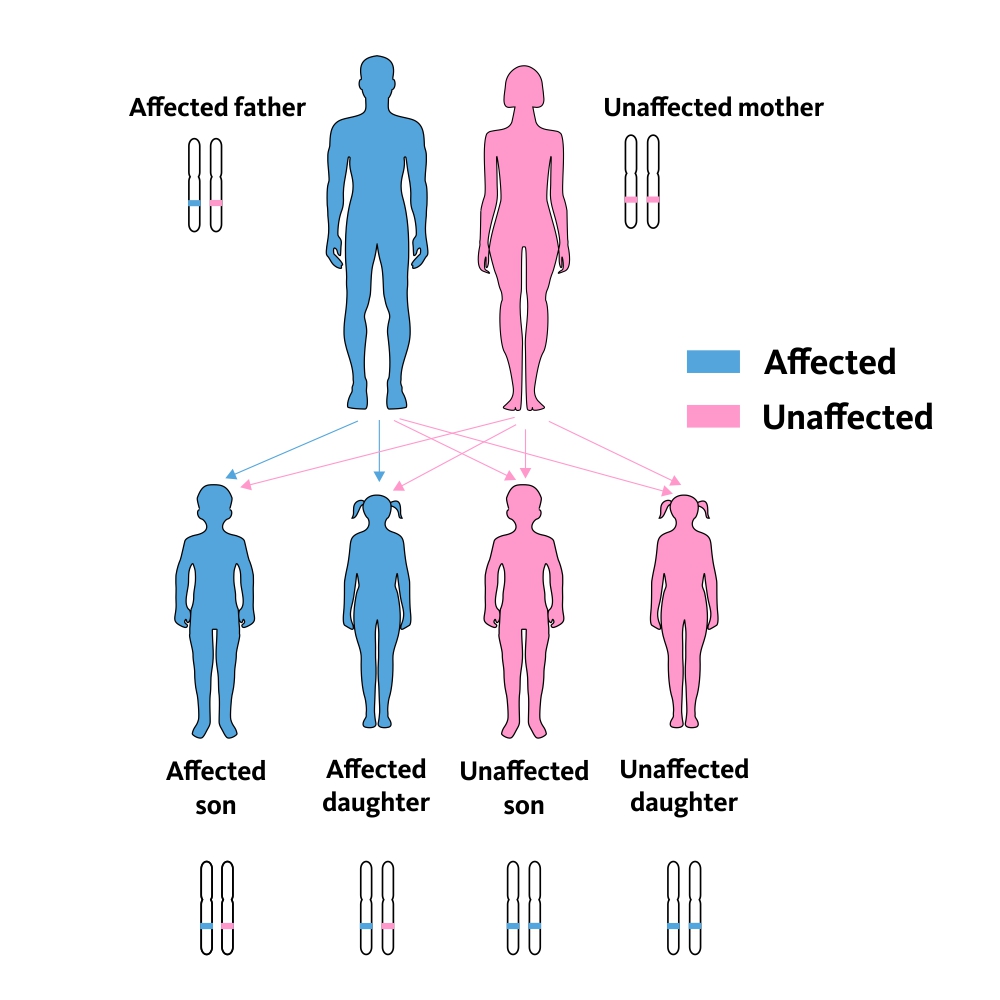
Familial Cancer
fr: cancer familial
Cancer that occurs in families more often than would be expected by chance. These cancers often occur at an early age, and may indicate the presence of a gene mutation that increases the risk of cancer. They may also be a sign of shared environmental or lifestyle factors.
Example: The pattern of inheritance across generations made it likely that this was a case of familial cancer.
Relevant Lessons:
Citations:
https://www.cancer.gov/publications/dictionaries/cancer-terms/def/familial-cancer

Flow Cytometry
fr: cytométrie en flux
A lab test used to analyze cells or tiny particles. During the process, a sample of cells or particles is suspended in fluid and injected into a flow cytometer machine. Approximately 10,000 cells can be analyzed and processed by a computer in less than one minute.
Example: Flow cytometry showed a decrease in the leukemia cells after initial treatment.
Relevant Lessons:
Citations:
https://my.clevelandclinic.org/health/diagnostics/22086-flow-cytometry
https://www.bosterbio.com/protocol-and-troubleshooting/flow-cytometry-principle

Fluorescence in-situ Hybridization (FISH)
fr: hybridation in situ en fluorescence
FISH is a molecular pathology technique used to detect the presence and location of specific DNA and RNA sequences within cells and tissue.
Example: FISH analysis showed that the HER2 gene was amplified in the patient’s invasive breast carcinoma sample.
Relevant Lessons:
Citations:

Formalin-Fixed Paraffin-Embedded (FFPE)
fr: Fixé au Formol et Intégré en Paraffine
FFPE refers to a method of preserving tissue samples for histological analysis. Tissue samples are fixed in formalin, dehydrated, and embedded in paraffin wax, allowing them to be stored for long periods while preserving cellular structure.
Example: The pathologist examined the formalin-fixed paraffin-embedded tissue samples under the microscope to determine the stage and grade of the patient’s cancer.
Relevant Lessons:
Citations:
https://pubmed.ncbi.nlm.nih.gov/30539450/#:~:text=Paraffin%20embedding%20is%20a%20standard,FFPE%20block%20or%20paraffin%20block.
https://dls.com/biospecimens/tissues/ffpe-tissue/

Frameshift Mutation
fr: mutation de décalage de cadre
A type of insertion or deletion of DNA bases in a gene that affects the “reading frame” of the gene’s instructions to shift and leads to incorrect protein production. Also called frameshift variant.
Example: A frameshift mutation in the MLH1 gene leads to a shortened protein and loss of mismatch repair function.
Relevant Lessons:
Citations:
https://www.cancer.gov/publications/dictionaries/genetics-dictionary/def/frameshift-mutation

Gene
fr: gène
Genes are pieces of DNA that provide instructions for cells the body to carry out various functions
Example: Mutations were detected in the EGFR gene that predicted the tumour would respond to tyrosine kinase inhibitors.
Relevant Lessons:
Citations:

Genetic Mutation
fr: mutation génétique
Relevant Lessons:
Citations:
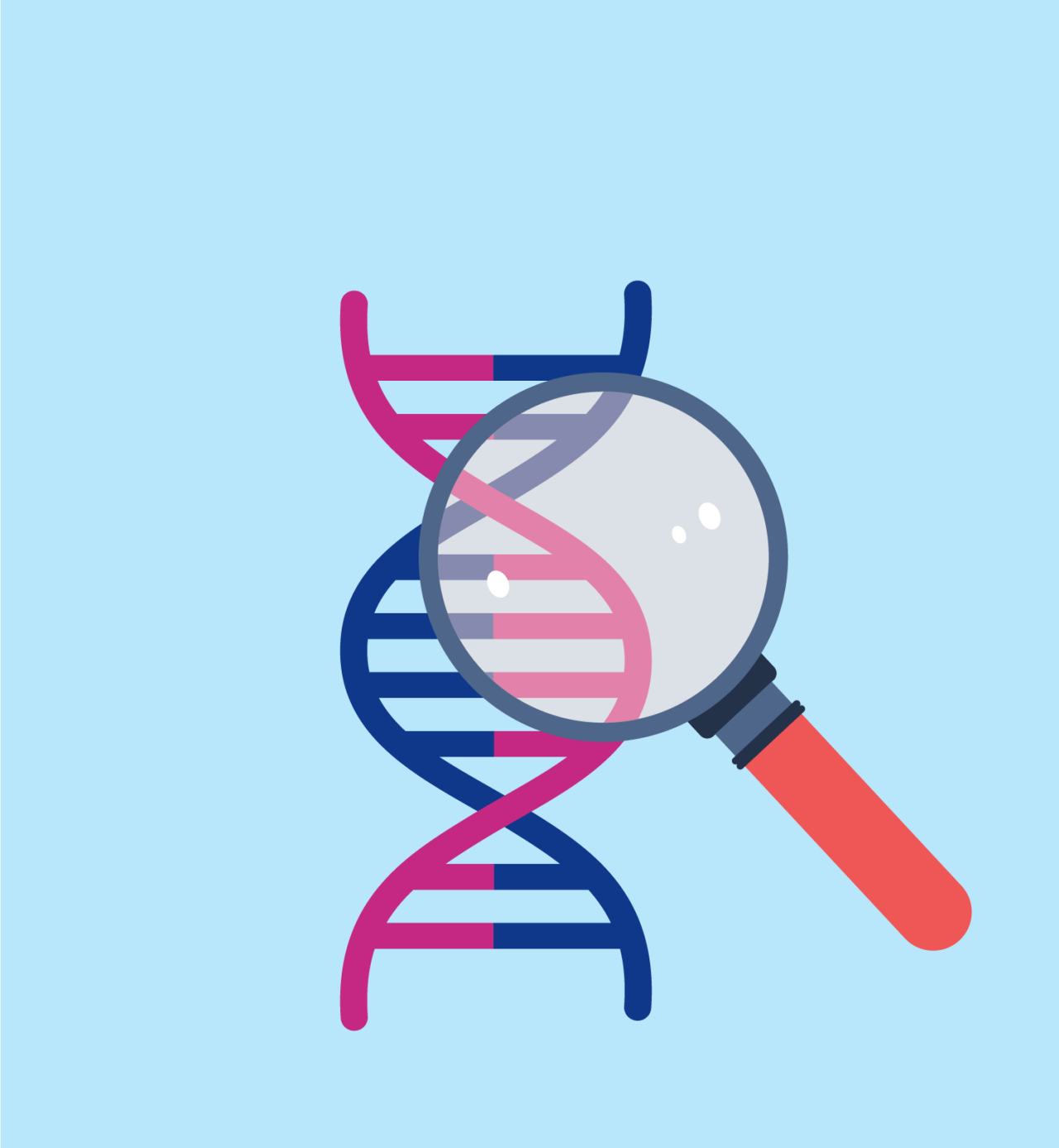
Genetic Testing
fr: Tests génétiques
Genetic testing is a medical procedure that analyzes a person’s DNA, chromosomes, or proteins to identify changes that may indicate a disease or condition
Example: Genetic testing indicated a mutation in the BRCA1 gene of the patient and his daughter.
Relevant Lessons:
Citations:

Genome
fr: génome
The complete set of DNA (genetic material) in an organism. In people, almost every cell in the body contains a complete copy of the genome. The genome contains all of the information needed for a person to develop and grow. Studying the genome may help researchers understand how different types of cancer form and respond to treatment. This may lead to new ways to diagnose, treat, and prevent cancer.
Example: Scientists are working diligently to decode the entire human genome, unlocking the secrets embedded in our DNA that influence traits, diseases, and overall health.
Relevant Lessons:
Citations:

Genomics
fr: génomique
Genomics is the study of the genes in a person’s genome. Genomic medicine uses genomic information as part of a person’s clinical care plan.
Example: Genomics analysis showed that the patient is a carrier of a BRCA1 cancer risk variant.
Relevant Lessons:
Citations:

Genotype
fr: Génotype
The genotype represents the genetic blueprint of an organism. It encompasses the entire selection of genetic information inherited from one’s ancestors.
Example: A research study focused on understanding the genotype of cancer cells, revealing specific genetic alterations that contribute to the uncontrolled growth and survival of the malignant cells.
Relevant Lessons:
Citations:
https://www.thedailyeco.com/what-is-the-difference-between-genotype-and-phenotype-351.html

Germline
fr: Lignée germinale
Germline DNA refers to tissue derived from reproductive cells (egg or sperm) that become incorporated into the DNA of every cell in the body of the offspring. A germline mutation may be passed from parent to offspring. Also called constitutional DNA.
Example: A germline mutation in the BRCA1 gene was identified. This pathogenic variant is associated with an increased risk of hereditary breast and ovarian cancer syndrome.
Relevant Lessons:
Citations:
https://www.cancer.gov/publications/dictionaries/genetics-dictionary/def/germline
https://www.genomicseducation.hee.nhs.uk/genotes/knowledge-hub/constitutional-germline-vs-somatic-tumour-variants/#:~:text=Constitutional%20(also%20known%20as%20germline,so%20are%20not%20passed%20on.
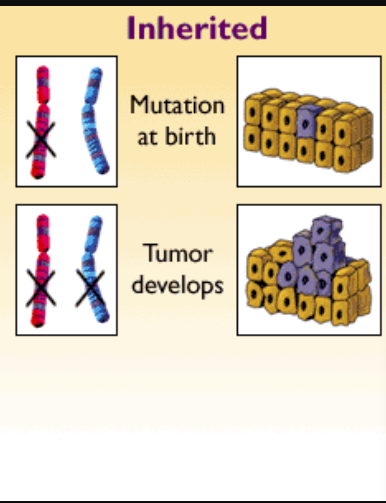
Hereditary Cancer
fr: cancer héréditaire
A type of inherited disorder in which there is a higher-than-normal risk of certain types of cancer. Hereditary cancer syndromes are caused by mutations (changes) in certain genes passed from parents to children. In a hereditary cancer syndrome, certain patterns of cancer may be seen within families.
Example: Hereditary cancer was likely because the the same variant was detected in one of the patient’s parents.
Relevant Lessons:
Citations:

Heterozygous
fr: hétérozygote
Refers to having inherited different versions (alleles) of a gene from each biological parent. Thus, an individual who is heterozygous for a gene has two different versions of that gene.
Example: DNA sequencing identified a heterozygous BRCA2 variant gene that is associated with an increased risk of hereditary breast and ovarian cancer syndrome.
Relevant Lessons:
Citations:

Histology
fr: histologie
The study of tissues and cells under a microscope.
Example: The histology showed the presence of abnormal cell patterns characteristic of pancreatic cancer.
Relevant Lessons:
Citations:
https://www.cancer.gov/publications/dictionaries/cancer-terms/def/histology

Histopathology
fr: histopathologie
Is the diagnosis and study of diseases of tissues and involves examining tissues and/or cells under a microscope. Pathologists are experts in histopathology.
Example: Histopathology of the excised mass revealed a poorly differentiated adenocarcinoma.
Relevant Lessons:
Citations:
https://www.rcpath.org/discover-pathology/news/fact-sheets/histopathology.html

Homozygous
fr: homologue
Homozygous refers to having inherited the same versions (alleles) of a genomic marker from each biological parent. An individual who is homozygous for a gene has two identical versions of that gene.
Example: A germline homozygous mutation in the DNA repair gene led to colon cancer development in the patient.
Relevant Lessons:
Citations:

Imaging Biomarker
fr: Biomarqueurs d’imagerie
Imaging Biomarkers are observable through imaging techniques like Magnetic resonance imaging (MRI), Computed Tomography (CT) scans, or Positron Emission Tomography (PET) scans. They are used to determine the location, size, and extent of the cancerous growth within the body.
Example: PSMA PET is an imaging biomarker that can be used to look for prostate cancer metastasis.
Relevant Lessons:
Citations:

Immune Checkpoint Inhibitors
fr: Inhibiteurs de points de contrôle immunitaires
Immune checkpoint inhibitors are a type of cancer immunotherapy drug that work by blocking proteins on immune system cells and cancer cells that prevent the immune system from attacking cancer cells
Example: Immunotherapy can be tailored for patients with cancers like melanoma by testing for biomarkers such as PD-L1 expression, which helps predict the likelihood of a positive response to immune checkpoint inhibitors.
Relevant Lessons:
Citations:

Immunofluorescence
fr: immunofluorescence
Immunofluorescence is a lab technique uses antibodies to detect the presence and location of proteins and other molecules within cells and tissue. The antibodies are labeled with a fluorescent dye and “glow” when exposed to ultraviolet light.
Example: In the laboratory, researchers used immunofluorescence to visualize specific proteins within cells by tagging them with fluorescent markers, allowing for detailed examination under a microscope.
Relevant Lessons:
Citations:

Immunostains
fr: Immunocoloration
Immunostaining is a process healthcare providers use to diagnose infections, cancers and other conditions. It identifies a specific protein (like a cancer-causing protein) from a mixture of other proteins in a sample of your blood or tissue.
Example: The pathologist utilized immunostains to enhance the visualization of specific proteins in the tissue sample, aiding in the accurate diagnosis of the patient’s medical condition.
Relevant Lessons:
Citations:
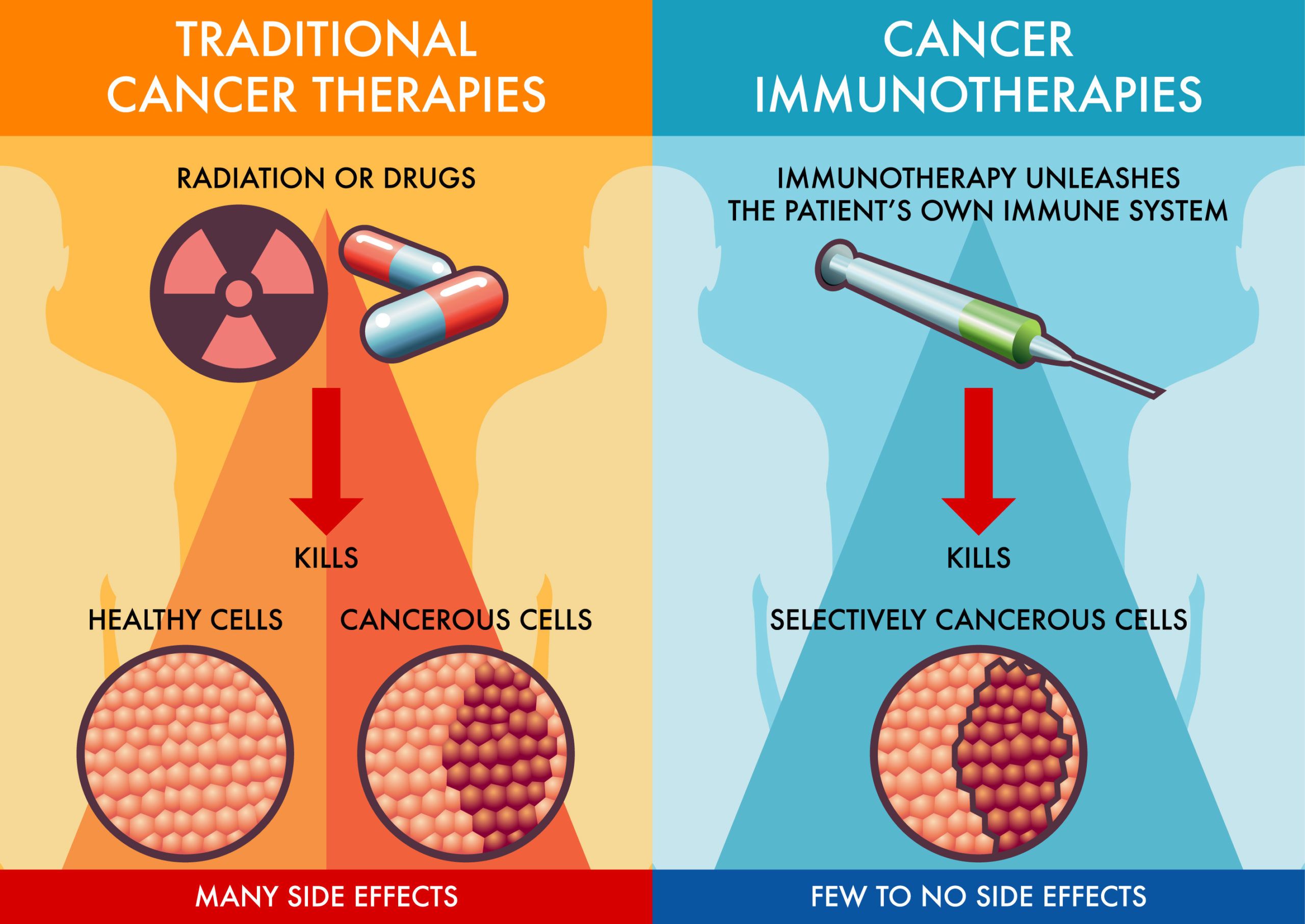
Immunotherapy
fr: Immunothérapie
Immunotherapy is a type of cancer treatment that helps your immune system fight cancer.
Example: Molecular testing on the tumour sample detected microsatellite instability, which indicated that the patient might respond to immunotherapy.
Relevant Lessons:
Citations:

In Silico Analysis
fr: Analyse in silico
In silico studies are biological experiments carried out entirely on a computer, or via a computer simulation
Example: In in silico analysis showed that the DNA variant would lead to a defective protein.
Relevant Lessons:
Citations:
https://mpkb.org/home/patients/assessing_literature/in_vitro_studies

Informed Consent
fr: consentement éclairé
Informed consent is a process that ensures participants understand the trial and voluntarily agree to participate. It involves educating potential participants about the study’s purpose, procedures, risks, benefits, and their rights.
Example: Before participating in the clinical trial, participants were provided with detailed information about the study and its potential risks and benefits, and they were required to sign an informed consent form to indicate their understanding and voluntary agreement to participate.
Relevant Lessons:
Citations:

Inherited
fr: hérité
Refers to a trait or variants encoded in DNA and passed from parent to offspring during reproduction.
Example: The increased risk of developing certain types of cancer can be influenced by inherited genetic mutations, as individuals may inherit genetic predispositions that make them more susceptible to the disease.
Relevant Lessons:
Citations:

Interventions
fr: interventions
A treatment, procedure, or other action taken to prevent or treat disease, or improve health in other ways.
Example: Clinical trials are testing new cancer treatments, such as immunotherapy, with the goal of finding more effective interventions for patients.
Relevant Lessons:
Citations:

Intronic Region
fr: région intronique
Introns are sections of an RNA transcript, or the DNA encoding it, that are cut out before the RNA molecule makes a protein. The sections of DNA (or RNA) that code for proteins is called exons.
Example: Researchers focused on the intronic region to study non-coding segments of the gene, revealing important information about regulatory elements and their influence on genetic processes
Relevant Lessons:
Citations:
https://www.nature.com/scitable/definition/intron-introns-67/
https://www.genome.gov/genetics-glossary/Intron#:~:text=Definition,consist%20of%20exons%20and%20introns.

Liquid Biopsy
fr: Biopsie liquide
Liquid biopsy is a medical test that uses fluids from the body. Blood is the most common liquid biopsy source, but saliva, urine or the fluid around organs (like the lungs and brain) can also be used.
Example: Given the non-invasive nature and the comprehensive genetic information it can provide, we are considering using liquid biopsy to monitor the tumor’s response to treatment and detect any potential recurrence early.
Relevant Lessons:
Citations:
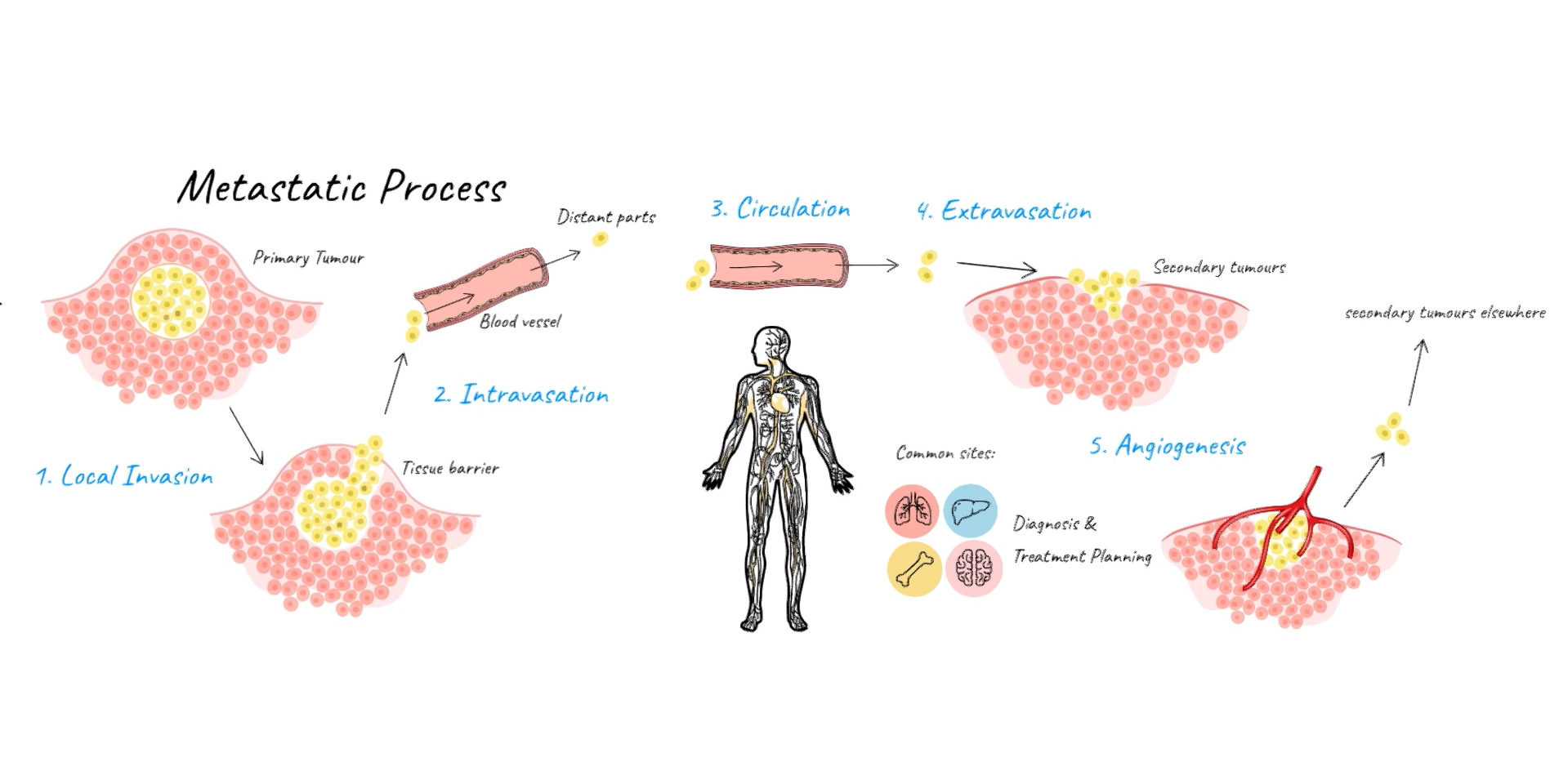
Local Invasion
fr: Invasion locale
Step 1 of the metastatic process by which cancer cells spread beyond the layer of tissue in which it developed and is growing into surrounding, healthy tissues.
Example: The pathologist observed local invasion of cancer cells into nearby tissues, which led to the destruction of healthy cells.
Relevant Lessons:
Citations:

Loss of Heterozygosity (LOH)
fr: Perte d’hétérozygotie
LOH refers to the loss of one allele at a specific genetic locus, resulting in a region of DNA becoming homozygous. LOH can occur through various mechanisms, including deletion, mutation, or chromosomal rearrangement, and is often associated with tumor suppressor gene inactivation.
Example: Loss of heterozygosity in the tumor samples indicated a potential genetic driver of the patient’s cancer, guiding treatment decisions towards therapies targeting specific mutated genes.
Relevant Lessons:
Citations:
https://www.genome.gov/genetics-glossary/Loss-of-Heterozygosity
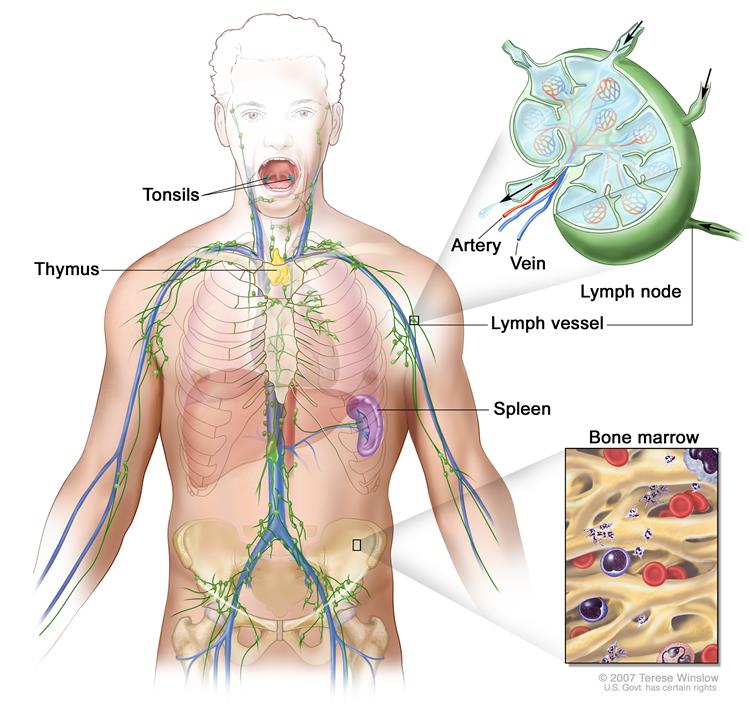
Lymph Node
fr: ganglion lymphatique
A small bean-shaped structure that is part of the body’s immune system. Lymph nodes filter substances that travel through the lymphatic fluid, and they contain lymphocytes (white blood cells) that help the body fight infection and disease.
Example: Immunohistochemistry and PCR were used to analyze the patient’s lymph nodes for evidence of metastasis.
Relevant Lessons:
Citations:

Machine Learning
fr: apprentissage automatique
Machine learning is a type of artificial intelligence where computers use large amounts of data to “learn” how to do various tasks without someone needing to program these individual abilities.
Example: The researchers found that their machine learning algorithm was able to accurately predict the type of cancer based on digital pathology images.
Relevant Lessons:
Citations:

Malignant
fr: maligne (feminine), malin (masculine)
A term used to describe cancer. Malignant cells grow in an uncontrolled way and can invade nearby tissues and spread to other parts of the body through the blood and lymphatic systems
Example: The pathology report confirmed the presence of malignant cells in the tissue, underscoring the urgency for a comprehensive and aggressive approach to treatment.
Relevant Lessons:
Citations:
https://www.cancer.gov/publications/dictionaries/cancer-terms/def/malignant
https://www.verywellhealth.com/what-does-malignant-and-benign-mean-514241

Mass Parallel Sequencing
fr: Séquençage parallèle de masse
A high-throughput method used to determine a portion of the nucleotide sequence of an individual’s genome. This technique utilizes DNA sequencing technologies that are capable of processing multiple DNA sequences in parallel. Also called next-generation sequencing or NGS.
Example: The laboratory employed mass parallel sequencing to simultaneously analyze thousands of DNA fragments, enabling rapid and comprehensive genomic profiling for research and diagnostic purposes.
Relevant Lessons:
Citations:

Metabolic Biomarker
fr: Biomarqueurs métaboliques
Reflect changes in chemical pathways in the body. Metabolic biomarkers are used to determine if there any metabolic abnormalities indicating the presence or aggressiveness of cancer.
Example: Increased levels of lactate in tumor tissues serve as metabolic biomarkers indicating tumor aggressiveness and poor prognosis in various cancers.
Relevant Lessons:
Citations:

Metastasis
fr: métastase
The spread of cancer cells from the place where they first formed to another part of the body. In metastasis, cancer cells break away from the original (primary) tumor, travel through the blood or lymph system, and form a new tumor in other organs or tissues of the body.
Example: Despite successful treatment of the primary tumor, metastasis of cancer cells to the lymph nodes indicated a more advanced stage of the disease, requiring additional therapy to target the spread of cancer.
Relevant Lessons:
Citations:

Microsatellite Instability (MSI)
fr: Instabilité des microsatellites
MSI is a condition characterized by the accumulation of errors in microsatellite DNA sequences, which are short repetitive sequences scattered throughout the genome.
Example: Molecular testing on the tumour sample detected microsatellite instability, which indicated that the patient might respond to immunotherapy.
Relevant Lessons:
Citations:
https://www.mdanderson.org/cancerwise/what-is-microsatellite-instability-MSI.h00-159617067.html

Molecular Assay
fr: essai moléculaire
Biological assays are experimental methods for assessing the presence, localization, or biological activity of a substance in living cells and biological matrices. Such methods are essential to biological science and technology.
Example: The researchers conducted a molecular assay to identify specific genetic mutations associated with the rare disorder, providing valuable insights into potential targeted therapies for affected individuals.
Relevant Lessons:
Citations:
Franken, N., Rodermond, H., Stap, J. et al. Clonogenic assay of cells in vitro. Nat Protoc 1, 2315–2319 (2006). https://doi.org/10.1038/nprot.2006.339

Molecular Biology
fr: biologie moléculaire
Molecular biology involves the study of very large molecules in the body like proteins and nucleic acids.
Example: Molecular biology studies how tiny components like DNA and proteins work together in cells, helping us grasp the foundation of life processes and diseases.
Relevant Lessons:
Citations:

Molecular Pathology
fr: pathologie moléculaire
Molecular pathology is a branch of pathology that focuses on the study of molecules found in tissues or bodily fluids. The presence of certain molecules can provide information about a person’s health status.
Example: The lab used a variety of molecular pathology techniques to test for mutations in the tumour and arrive at a cancer diagnosis.
Relevant Lessons:
Citations:

Molecular Targets
fr: Cibles moléculaires
Molecular targets are specific molecules in the body that are closely associated with cancer processes. Different biological molecules can potentially serve as targets, including proteins, DNA, and RNA.
Example: In cancer treatment, identifying specific molecular targets allows for the development of precision therapies that aim to selectively disrupt the growth and survival of cancer cells while minimizing damage to healthy tissues.
Relevant Lessons:
Citations:

Monitoring Biomarker
fr: Surveillance des biomarqueurs
Monitoring biomarkers track disease progression or treatment response over time. These biomarkers tries to answer the question of how is the cancer progressing or responding to treatment over time?
Example: Circulating tumor DNA (ctDNA) levels are monitoring biomarkers used to track disease progression and treatment response in advanced cancers.
Relevant Lessons:
Citations:

Monoclonal Antibody
fr: anticorps monoclonal
Monoclonal antibodies are laboratory-produced proteins that can bind to specific targets in the body, such as antigens on cancer cells.
Example: Because her breast cancer cells had high levels of the HER2 protein, the doctor prescribed a monoclonal antibody treatment to specifically target those cells.
Relevant Lessons:
Citations:

Next-Generation Sequencing
fr: Séquençage de nouvelle génération
See Massively Parallel Sequencing.
Example: Coding regions and select clinically significant non-coding regions of the BRCA1 gene was tested by NGS for genetic variants.
Relevant Lessons:
Citations:

Nucleic Acids
fr: Acides nucléiques
Nucleic acids are the building blocks of DNA (deoxyribonucleic acid) and RNA (ribonucleic acid). DNA and RNA are polymers and they are made up of many nucleotides joined end-to-end.
Example: Nucleic acids, such as DNA and RNA, are essential molecules that carry genetic information and play crucial roles in various cellular processes, including protein synthesis and the storage of genetic instructions.
Relevant Lessons:
Citations:

Nucleotide
fr: Nucléotide
A molecule that is the basic building block of the nucleic acids DNA and RNA. A nucleotide is made up of a nitrogen-containing base (adenine, guanine, thymine, and cytosine in DNA, and adenine, guanine, uracil, and cytosine in RNA), a phosphate group, and a sugar molecule (deoxyribose in DNA, and ribose in RNA). DNA and RNA are polymers made up of many nucleotides.
Example: DNA sequencing was used to identify the precise nucleotide that was mutated in the BRCA1 gene.
Relevant Lessons:
Citations:
https://www.cancer.gov/publications/dictionaries/genetics-dictionary/def/nucleotide
https://www.genome.gov/genetics-glossary/Nucleotide

Patient Partner
fr: patient partenaire
Patient partners have lived experience as a cancer patient, family member or caregiver. Patient partners bring their insight and perspective to a research project or organization.
Example: The hospital implemented a patient engagement initiative, appointing a patient partner to work closely with healthcare professionals, sharing their experiences and perspectives to improve the overall quality of care and services.
Relevant Lessons:
Citations:
https://cihr-irsc.gc.ca/e/53242.html
https://healthexperiences.ca/patient-researcher-partnerships/

Polymerase Chain Reaction (PCR)
fr: Réaction en chaîne par polymérase (RAP)
Polymerase Chain Reaction (PCR) is a laboratory technique for creating millions or billions of copies of a specific piece of DNA.
Example: The laboratory conducted polymerase chain reaction (PCR) tests to amplify and analyze specific DNA sequences, allowing for the detection of genetic markers associated with the targeted disease.
Relevant Lessons:
Citations:

Peer Review
fr: examen par les pairs
The process by which original articles and grants written by researchers are evaluated for technical and scientific quality and correctness by other experts in the same field.
Example: The scientist submitted their research paper for peer review, where other experts in the field examined and approved it before it could be published.
Relevant Lessons:
Citations:
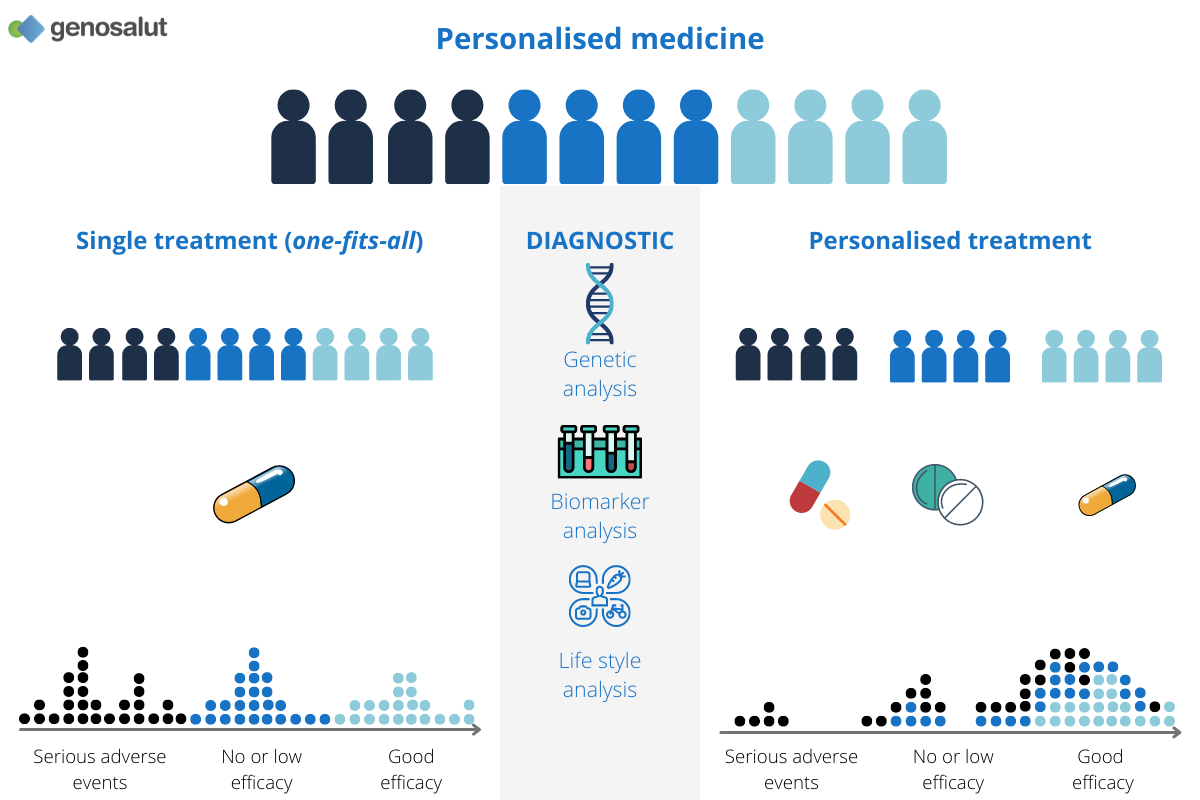
Personalised Medicine
fr: Médecine personnalisée
Personalised medicine is an emerging practice of medicine that uses an individual’s genetic profile to guide decisions made in regard to the prevention, diagnosis, and treatment of disease.
See: Precision Medicine
Relevant Lessons:
Citations:

Phase 1 Clinical Trials
fr: essais cliniques de phase 1
A phase I clinical trial tests the safety, side effects, best dose, and timing of a new treatment. It may also test the best way to give a new treatment (for example, by mouth, infusion into a vein, or injection) and how the treatment affects the body. Phase I clinical trials usually include only a small number of patients or healthy volunteers.
Example: The investigational drug successfully completed preclinical studies and has now advanced to phase 1 clinical trials, where its safety and dosage levels will be assessed in a small group of human volunteers.
Relevant Lessons:
Citations:

Phase 2 Clinical Trials
fr: essais cliniques de phase 2
Phase 2 clinical trials tests whether a new treatment works for a certain type of cancer or disease. Phase II trials may also provide more information about the safety of the new treatment and how the treatment affects the body. Phase 2 trials involve greater numbers of participants compared to phase 1 trials.
Example: Following promising results from phase 1 clinical trials, the experimental medication has progressed to phase 2 clinical trials, involving a larger group of participants to further evaluate its efficacy and safety profile.
Relevant Lessons:
Citations:

Phase 3 Clinical Trials
fr: essais cliniques de phase 3
Phase 3 clinical trials tests the safety and how well a new treatment works compared with a standard treatment. Treatments move into phase 3 clinical trials only after they meet the goals of phase 1 and phase 2 clinical trials. Phase 3 clinical trials may include hundreds of people.
Example: The pharmaceutical company is eagerly awaiting the results of the phase 3 clinical trials, the final stage of testing, to determine whether the new treatment meets the necessary criteria for regulatory approval.
Relevant Lessons:
Citations:

Phase 4 Clinical Trials
fr: essais cliniques de phase 4
Phase 4 clinical trials study the long-term side effects of a new treatment. Phase 4 clinical trials may include thousands of people.
Example: After regulatory approval, the novel medication entered phase 4 clinical trials, monitoring its real-world effectiveness and safety in a broader patient population to gather additional post-marketing data.
Relevant Lessons:
Citations:

Phenotype
fr: Phénotype
The phenotype constitutes the visible aspects of a person resulting from the instruction in their genome. In essence, the genotype serves as the underlying script, dictating what should be expressed at the phenotype (visible) level.
Example: In a recent study of breast cancer, the triple-negative phenotype was associated with tumors lacking expression of estrogen receptors, progesterone receptors, and HER2, influencing the prognosis and treatment approach for patients with this specific cancer phenotype.
Relevant Lessons:
Citations:
https://www.thedailyeco.com/what-is-the-difference-between-genotype-and-phenotype-351.html

Placebo
fr: placebo
A placebo is an inactive substance or treatment that looks like the real intervention but has no therapeutic effect. It is often used in clinical trials to compare the effects of the real treatment with no treatment at all.
Example: During the clinical trial, half of the participants were given the new intervention, while the other half received a placebo to evaluate the drug’s effectiveness in a controlled and unbiased manner.
Relevant Lessons:
Citations:

Plasma
fr: plasma
Plasma is the liquid component of your blood that contributes to about 60% of your blood’s total volume. Plasma is necessary to help your body recover from injury, distribute nutrients, remove waste and prevent infection, while moving throughout your circulatory system.
Example: The laboratory technician carefully processed the blood sample, separating the red blood cells from the plasma, which contains various proteins and other components.
Relevant Lessons:
Citations:

Precision Medicine
fr: médecine de précision
Precision medicine is a medical approach that tailors treatment and prevention strategies to individual characteristics of each patient, such as genetics, environment, and lifestyle. The goal is to provide more effective and personalized healthcare.
Also called personalized medicine.
Example: The advancement of precision medicine allows healthcare providers to tailor treatment plans based on an individual’s genetic makeup, leading to more personalized and effective healthcare interventions.
Relevant Lessons:
Citations:

Preclinical Development Phase
fr: phase de développement préclinique
Research using cells or animals to find out if a drug, procedure, or treatment is likely to be useful. Preclinical studies take place before any testing in humans is done.
Example: Before a new drug can be tested on humans, it must undergo rigorous evaluation during the preclinical development phase to ensure its safety and effectiveness in cells or animals.
Relevant Lessons:
Citations:

Predictive Biomarker
fr: Biomarqueurs prédictifs
Predicts response to treatment or therapy and tries to answer the question of how likely is it that a specific treatment or therapy will be effective?
Example: Epidermal Growth Factor Receptor (EGFR) mutation status in non-small cell lung cancer is used as a predictive biomarker, as it predicts response to targeted therapies against EGFR.
Relevant Lessons:
Citations:

Primary Tumour
fr: tumeur primitive
A term used to describe the original, or first, tumor in the body. Cancer cells from a primary tumor may spread to other parts of the body and form new, or secondary, tumors. This is called metastasis. These secondary tumors are the same type of cancer as the primary tumor.
Example: The primary tumour, located in the colon, was successfully removed through surgery, but further tests were needed to determine if it had spread to other organs.
Relevant Lessons:
Citations:

Prognostic Biomarker
fr: Biomarqueurs pronostiques
Provides information about disease progression and outcome. Answers the question of what is the likely course of the disease and what are the expected outcomes?
Example: An elevated level of circulating tumor cells (CTCs) is a prognostic biomarker associated with poor outcomes in a variety of cancers.
Relevant Lessons:
Citations:

Promoter Region
fr: région promotrice
A region of DNA before the first exon of a gene that tells the cell when the gene should be made in a process called transcription.
Example: DNA methylation in the promoter region prevented the gene from being expressed in the patient’s tumour.
Relevant Lessons:
Citations:

Protein Biomarker
fr: Biomarqueurs protéiques
Proteins detected in biological samples like blood, urine, or tissues. Protein biomarkers are used to see if there are any abnormal levels of specific proteins associated with cancer present in the body.
Example: CA-125 is a protein biomarker used for monitoring ovarian cancer progression and response to treatment.
Relevant Lessons:
Citations:

Proteomics
fr: protéomique
The study of the structure and function of proteins, including the way they work and interact with each other inside cells.
Example: The researchers used proteomics to study colorectal tumours and identify new cancer biomarkers.
Relevant Lessons:
Citations:

Protocol
fr: protocole
A clinical trial protocol is a detailed plan that describes the objectives, design, methodology, and conduct of a clinical trial. The protocol includes who can participate, what treatments will be given, and how data will be collected and analyzed.
Example: Before starting the clinical trial, researchers carefully outlined the protocol, specifying the procedures, criteria, and ethical guidelines to ensure a standardized and well-controlled study.
Relevant Lessons:
Citations:

Recessive
fr: récessif (masculine), récessive (feminine)
Individuals inherit two versions of each gene, known as alleles, from each parent. In the case of a recessive trait, the alleles of the trait-causing gene are the same, and both (recessive) alleles must be present to express the trait. A recessive allele does not produce a trait at all when only one copy is present. This contrasts to a dominant trait, which requires that only one of the two alleles be present to express the trait.
Example: While most cancer-related mutations are dominant and lead to abnormal cell growth, recessive mutations require both copies of a gene to be altered before contributing to the development of the disease.
Relevant Lessons:
Citations:
https://www.genome.gov/genetics-glossary/Recessive-Traits-Alleles
Refractory Cancer
fr: épisode réfractaire
Refractory cancer is cancer that fails to respond to treatment or continues to progress despite treatment. Refractory cancer may also be called resistant cancer.
Example: Despite undergoing multiple rounds of treatment, the patient’s cancer remained refractory, posing significant challenges for the medical team in finding an effective therapeutic approach.
Relevant Lessons:
Citations:
https://www.news-medical.net/health/What-is-Refractory-Cancer.aspx

Risk Biomarker
fr: Biomarqueurs de risque
Risk biomarkers are derived from genetic material such as DNA or RNA. They answer the question of is there a genetic predisposition to cancer, and if so, which specific gene variants are present?
Example: Certain BRCA1 and BRCA2 variants are risk biomarkers associated with increased chance of developing cancer.
Relevant Lessons:
Citations:

Ribonucleic Acid (RNA)
fr: Acide ribonucléique (ARN)
RNA stands for ribonucleic acid. It is a type of nucleic acid found in all the cells of your body. RNA can act as a messenger that instructs a cell how to produce a protein. Certain RNAs can also perform cellular functions on their own.
Example: In molecular pathology, researchers may examine RNA expression profiles to uncover abnormal patterns indicative of disease, allowing for a more precise understanding of the molecular mechanisms underlying pathological conditions.
Relevant Lessons:
Citations:

Secondary Tumour
fr: tumeur primitive
A term used to describe cancer that has spread (metastasized) from the place where it first started to another part of the body. Secondary tumors are the same type of cancer as the original (primary) cancer.
Example: A secondary tumour was discovered in the liver during a follow-up scan, indicating that cancer cells had spread from the primary tumor in the colon.
Relevant Lessons:
Citations:

Single Nucleotide Polymorphism/ Single Nucleotide Variant (SNP, SNV)
fr: Polymorphisme nucléotidique unique/ Variante nucléotidique unique
SNPs and SNVs are variations in a single nucleotide at a specific position in the genome.
Example: Molecular testing on the patient’s sample identified several single nucleotide polymorphisms in the BRCA1 gene but none of them were associated with elevated cancer risk.
Relevant Lessons:
Citations:
https://medlineplus.gov/genetics/understanding/genomicresearch/snp/
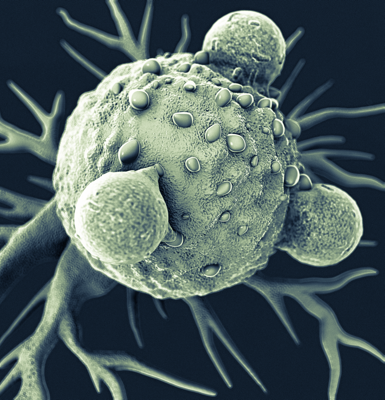
Solid Tumour
fr: tumeur solide
Solid tumors are abnormal masses of tissue that result from the uncontrolled growth of cells. They can be benign (non-cancerous) or malignant (cancerous) and can originate in various organs and tissues throughout the body.
Example: The scan confirmed the presence of a solid tumour. Further tests would have to be done in order to determine whether the tumour was malignant.
Relevant Lessons:
Citations:

Somatic
fr: somatique
Cells that are not part of the germline are called somatic cells, and any changes to the DNA that occur within these cells are known as somatic variants. Somatic variants are not present in every cell in the body, and are not passed from parent to child.
Example: DNA sequencing of the BRAF gene revealed a somatic variant. Targeted therapy with a BRAF inhibitor should be considered.
Relevant Lessons:
Citations:

Sporadic Cancer
fr: cancer sporadique
Cancer that occurs in people who do not have an inherited genetic variant that would increase their risk for that cancer.
Example: Because her cancer wasn’t linked to inherited genes or family history, the doctor said it was sporadic cancer.
Relevant Lessons:
Citations:
https://www.cancer.gov/publications/dictionaries/genetics-dictionary/def/sporadic-cancer

Targeted Therapy
fr: Thérapie ciblée
Targeted therapy is a type of cancer treatment that targets proteins that control how cancer cells grow, divide, and spread.
Example: Tests revealed a specific mutation in the patient’s tumour that was known to respond to targeted therapy.
Relevant Lessons:
Citations:

The Cancer Genome Atlas (TCGA)
fr: L’Atlas du génome du cancer
TCGA is a comprehensive database that catalogues genomic, transcriptomic, and epigenomic data from thousands of cancer patients across different cancer types. It serves as a valuable resource for cancer research and personalized medicine initiatives.
Example: The Cancer Genome Atlas (TCGA) project has provided researchers with a comprehensive database of genomic alterations across various cancer types, revolutionizing our understanding of cancer biology and informing the development of personalized cancer treatments.
Relevant Lessons:
Citations:
https://www.genome.gov/Funded-Programs-Projects/Cancer-Genome-Atlas

Therapeutic Biomarker
fr: Biomarqueurs thérapeutiques
Monitors and predicts the effect of treatment and answers the question of how is the current treatment working for the patient.
Example: Carcinoembryonic Antigen (CEA) is used as a therapeutic biomarker to monitor treatment response in colorectal cancer. Decreasing CEA levels means that the cancer is responding to therapy.
Relevant Lessons:
Citations:

Tissue
fr: Tissulaire
A group or layer of cells that work together to perform a specific function.
Example: The pathologist carefully examined the tissue obtained during the biopsy, analyzing cellular structures and identifying any abnormalities to provide an accurate diagnosis of the patient’s medical condition.
Relevant Lessons:
Citations:

TNM Cancer Staging System
fr: Système de stadification du cancer TNM
A system to describe the amount and spread of cancer in a patient’s body, using TNM. T describes the size of the tumor and any spread of cancer into nearby tissue; N describes spread of cancer to nearby lymph nodes; and M describes metastasis (spread of cancer to other parts of the body).
Example: The oncologist reviewed the TNM classification of the patient’s lung cancer to determine the most effective treatment plan.
Relevant Lessons:
Citations:

Tumour Biomarker Tests
fr: Tests de biomarqueurs tumoraux
A tumor biomarker test, also known as a tumor test, is a laboratory procedure that analyzes a sample of tissue, blood, or other bodily fluid to detect the presence of specific proteins, genes, or other molecules. These substances, called biomarkers or tumor markers, can provide information about cancer.
Example: Tumor biomarker tests detected KRAS mutations that were used to guide treatment decisions and predict the patient’s response to specific therapies.
Relevant Lessons:
Citations:

Tumour Mutational Burden (TMB)
fr: Charge mutationnelle tumorale
TMB is a measure of the total number of mutations present in the DNA of tumor cells. It is used as a biomarker to assess the overall mutational load of a tumor and may correlate with response to immunotherapy and prognosis in certain cancers.
Example: The tumour had a high tumor mutational burden, which let the doctors know that the patient is more likely to respond to immunotherapy.
Relevant Lessons:
Citations:
https://www.cancer.gov/publications/dictionaries/cancer-terms/def/tumor-mutational-burden

Variant
fr: Une variante
Any change in the DNA sequence of a cell. Variants may be caused by mistakes during cell division, or they may be caused by exposure to DNA-damaging agents in the environment. Variants can be harmful, beneficial, or have no effect. If they occur in cells that make eggs or sperm, they can be inherited; if variants occur in other types of cells, they are not inherited. Certain variants may lead to cancer or other diseases. A variant is sometimes called a mutation.
Example: Scientists analyze the genetic material of individuals to identify and characterize genetic variants that may be associated with increased susceptibility to certain diseases.
Relevant Lessons:
Citations:

Variant Allele Frequency (VAF)
fr: Variante de fréquence des allèles
VAF is the proportion of sequencing reads that contain a specific genetic variant relative to the total number of reads covering that position. It provides information about the abundance of a variant within a sample.
Example: A high variant allele frequency in the sample allowed the molecular pathologist to confidently diagnose the tumour and identify the appropriated targeted therapy.
Relevant Lessons:
Citations:
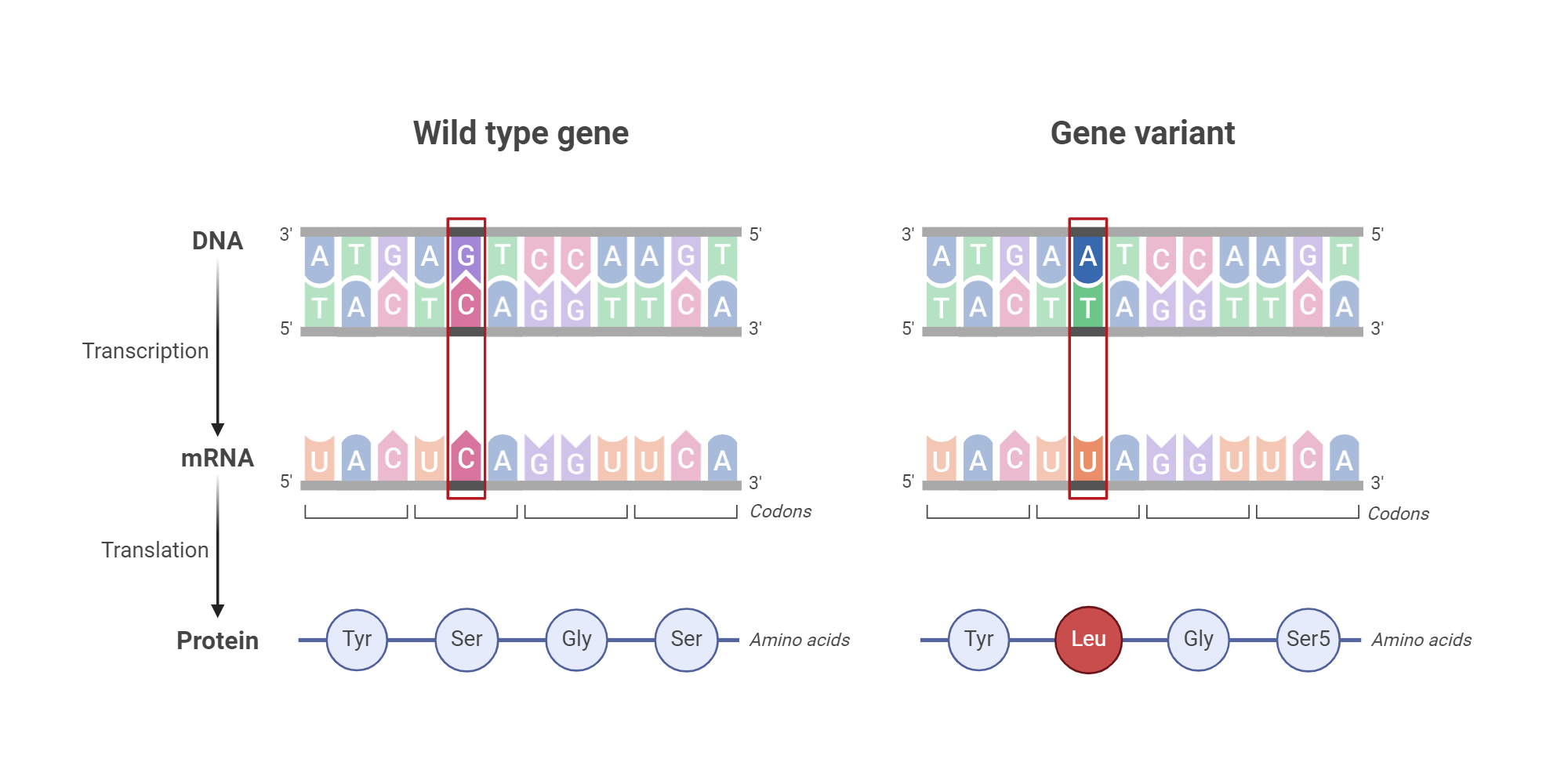
Wildtype
fr: gène de type sauvage
Genes that do not contain variants are called “wildtype.”
Example: Molecular tests indicated that she had the wildtype version of the EGFR gene, which meant that tyrosine kinase inhibitors was unlikely to be an effective treatment.
Relevant Lessons:
Citations:
https://www.cancer.gov/publications/dictionaries/cancer-terms/def/wild-type-gene

